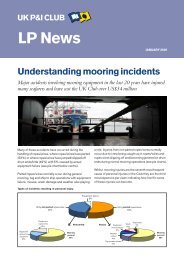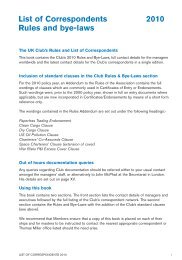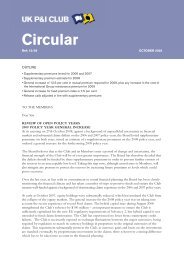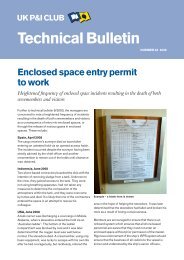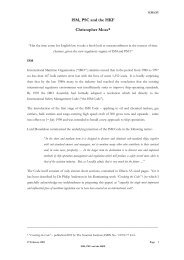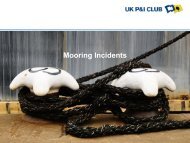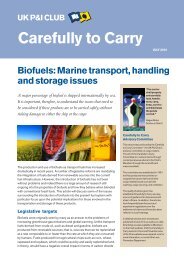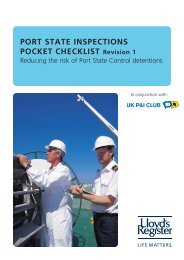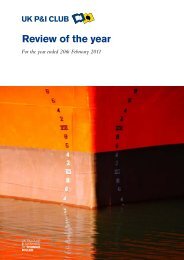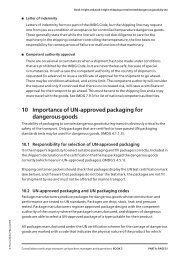Flexitanks - UK P&I
Flexitanks - UK P&I
Flexitanks - UK P&I
Create successful ePaper yourself
Turn your PDF publications into a flip-book with our unique Google optimized e-Paper software.
Carefully to Carry<br />
<strong>Flexitanks</strong><br />
“The carrier shall<br />
properly and carefully<br />
load, handle,<br />
stow, carry, keep,<br />
care for and discharge<br />
the goods<br />
carried.”<br />
Hague Rules,<br />
Articles iii, Rule 2<br />
Carefully to Carry<br />
Advisory Committee<br />
This report was produced by the<br />
Carefully to Carry Committee – the<br />
<strong>UK</strong> P&I Club’s advisory committee on<br />
cargo matters. The aim of the Carefully<br />
to Carry Committee is to reduce claims<br />
through contemporaneous advice to<br />
the Club’s Members through the most<br />
efficient means available.<br />
Introduction<br />
What is a flexitank? A flexitank is a<br />
bladder that is designed to fit inside a<br />
20ft general freight container and which<br />
converts that freight container into a nonhazardous<br />
bulk liquid transportation unit.<br />
<strong>Flexitanks</strong> are not an approved form of<br />
packaging for the carriage by sea of<br />
dangerous goods classified under the<br />
International Maritime Dangerous<br />
Goods Code.<br />
<strong>Flexitanks</strong> have been used for the<br />
carriage of bulk liquids for over twenty<br />
years. However, there has been<br />
unprecedented expansion since 2000<br />
with the emergence of single-trip tanks.<br />
In the early years, shipments amounted<br />
to around 5,000 per annum. In 2006<br />
the total global market had increased to<br />
about 120,000 flexitank movements.<br />
Annual growth is forecast at between<br />
15% and 20%. Of the present trade, it<br />
is estimated that between 15% and 20%<br />
of global loads emanate from South<br />
America, with the movement of wine and<br />
fruit juices being particularly prominent.<br />
The flexitank market is divided between<br />
equipment suppliers and equipment<br />
operators. A particularly dominant<br />
equipment manufacturer and operator<br />
is Trans Ocean Distribution Limited<br />
which has approximately 45% of the<br />
global market. Some of the newer<br />
entrants include a number of the<br />
conventional tanktainer operators,<br />
such as Stolt Nielsen Transportation<br />
Group and Hoyer Global.<br />
There are more than 40 manufacturers<br />
of flexitanks worldwide. There is<br />
presently no agreed standard regarding<br />
The committee was established in<br />
1961 and has produced many articles<br />
on cargoes that cause claims and<br />
other cargo related issues such as<br />
hold washing, cargo securing, and<br />
ventilation.<br />
The quality of advice given has<br />
established Carefully to Carry as a key<br />
source of guidance for shipowners<br />
and ships’ officers. In addition, the<br />
articles have frequently been the<br />
source of expertise in negotiations<br />
over the settlement of claims and have<br />
also been relied on in court hearings.<br />
In 2002 all articles were revised and<br />
published in book form as well as on<br />
disk. All articles are also available to<br />
Members on the Club website.<br />
Visit the Carefully to Carry section in<br />
the Loss Prevention area of the Club<br />
website www.ukpandi.com for more<br />
information, or contact the Loss<br />
Prevention Department.
construction and operation. However, the Container Owners<br />
Association (COA) set up a flexitank working group with<br />
the inaugural meeting held in Paris on 28 June 2007. The<br />
aims include producing a ‘Standard’ and a ‘Code of Practice’<br />
that flexitank manufacturers, operators and container<br />
operators can follow.<br />
Container operators are concerned that the pressure placed<br />
on the sidewall panels can result in them bulging beyond<br />
accepted ISO external dimensions and tolerances and<br />
permanent deformation can occur. Some operators are so<br />
concerned that they will not accept the shipment of flexitanks.<br />
Many feel that there should be a limit on how much can be<br />
carried in a flexitank.<br />
No return loads are required; and<br />
Loading rates are higher compared to drums and IBCs.<br />
The disadvantages of flexitanks include:<br />
Products classified as Dangerous Goods under the<br />
IMDG Code are not permitted;<br />
Pumps are required for unloading;<br />
Greater preparation is required than for ISO tank<br />
containers, although ISO tanks require substantial<br />
cleaning, especially in food applications;<br />
Environmental issues arise in connection with the<br />
disposal of used single-trip flexitanks;<br />
The risk of leakage of the full contents;<br />
The potential of high costs to clean up spillages; and<br />
Dependant upon stowage on board, spillage resulting in<br />
the contamination of other cargo.<br />
The International Standard Organisation (ISO) / Institute<br />
of International Container Lessors (IICL) deformation limit<br />
for sidewall panels is a maximum of 10mm beyond the<br />
plane of the side surfaces of the corner casting fittings.<br />
Perceived advantages/disadvantages<br />
In the non-hazardous markets, flexitanks are considered<br />
in some quarters to be effective substitutes for ISO tank<br />
containers and drums.<br />
Reasons put forward to justify single-use flexitanks include:<br />
Product dedicated and therefore no risk of cross<br />
contamination;<br />
Relatively low positioning costs (in some areas 100 empty<br />
flexitanks can be positioned for the same cost as one<br />
tank container);<br />
Positioning a flexitank with a capacity of up to 24,000 litres<br />
inside a 20ft general freight container enables shippers<br />
to despatch about 40% more cargo per container than a<br />
drummed consignment, about 50% more than a bottled<br />
consignment and about 15% additional payload when<br />
compared to a container filled with intermediate bulk<br />
containers (IBCs);
Types of flexitanks<br />
The first flexitanks were designed on the basis that they<br />
would be for multi-trip use. This meant that cleaning and<br />
repositioning costs were incurred. However, these costs<br />
have been eliminated with the singletrip flexitank, the type<br />
now most commonly in use. The single-trip type now<br />
accounts for more than 95% of the global market.<br />
The typical capacity of a flexitank is in the range of 10,000 to<br />
24,000 litres. The weight carried will depend upon the density<br />
of the commodity. The permitted gross weight of a container<br />
should never be exceeded, however, current practice is not<br />
to load more than 24,000 kg of liquid in a 30 metric tonne<br />
gross weight rated freight container, although even this is<br />
considered too high by some container operators.<br />
A major difference between the designs of the two types of<br />
flexitanks is that a restraining harness is used in the majority<br />
of multi-trip ones. Harnesses were, and still are, deemed to<br />
be dangerous as they create concentrated pressure points<br />
on the tank surface which can result in premature material<br />
failure. The use of a restraining harness has been dispensed<br />
with in the case of single-trip flexitanks.<br />
If a flexitank is not filled to near its nominal capacity then a<br />
marked free surface effect and hydraulic surging of the liquid<br />
can occur, often resulting in damage to the container. A flow<br />
meter should be used to ensure that a flexitank has been<br />
filled to its correct capacity (+/-500 litres of its nominal<br />
capacity). A visual inspection alone is unlikely to be sufficient.<br />
Use of flexitanks<br />
A range of products are carried in flexitanks and include wine,<br />
fruit concentrate, animal fat, fish oil, base oil, detergents,<br />
non-hazardous chemicals, drilling mud additives, paint,<br />
lubricants, printing ink, latex and potable water.<br />
<strong>Flexitanks</strong> are constructed in a number of different ways –<br />
singlelayered and multi-layered – and from different materials,<br />
but typically polyethylene. A shipper should discuss with a<br />
flexitank operator the most suitable type of flexitank that will<br />
be compatible with the product to be shipped. This may<br />
include giving consideration as to whether a flexitank should<br />
incorporate an impermeable barrier to prevent any tainting<br />
of the product being carried from external sources. For<br />
example, wine has been tainted by naphthalene, the origin<br />
of which has not always been clearly identified.<br />
Single-layered flexitanks are constructed from 1mm thick<br />
polyethylene, whereas multi-layered flexitanks are constructed<br />
from a number of layers of plastic of which the inner surface<br />
at least should be polyethylene. Each layer may be about<br />
125 microns thick. The outer layer of a multi-layered flexitank<br />
is normally of a woven type plastic material. With multilayered<br />
flexitanks, the different layers may, during loading,<br />
get caught up and trapped resulting in a layer tearing.<br />
Selection of freight container<br />
From discussions with a number of interested parties the<br />
general consensus is that a minimum 30 metric tonne gross<br />
weight rated container manufactured from Corten steel should<br />
be used, irrespective of the size of the flexitank. The actual<br />
sidewall strength is a function of a containers’ permitted<br />
payload, i.e. 0.6 x payload (ISO 1496-1 Series 1 freight<br />
containers - specification and testing). Therefore, the sidewall<br />
panels of a 30 mt container will have been tested to a<br />
greater load bearing capability than, say, a 24 mt container.<br />
The side wall test requires a general freight container to be<br />
subjected to an internal loading uniformly distributed and<br />
arranged to allow free deflection of the side wall and its<br />
longitudinal members. The ISO Standard requires that, upon<br />
completion of the test, the container exhibits neither permanent<br />
deformation which will render it unsuitable for use, nor any<br />
abnormality which will render it unsuitable for use and that<br />
the dimensional requirements governing handling, securing<br />
and interchange shall be satisfied. Therefore, for a 30 mt<br />
container the test load will be of the order of 16.8 mt.<br />
However, a flexitank does not place a uniform loading over<br />
the full area of a sidewall and a gross liquid cargo weight<br />
of 24,000 kgs is the recommended maximum by some<br />
flexitank operators. However, some container operators<br />
consider that there should be a lower limit. Containers are<br />
not specifically classified for the carriage of flexitanks.<br />
To minimise the stress upon the sidewalls of a freight<br />
container it is recommended that the height of the side of<br />
the flexitank in contact with the sidewall panel should be<br />
kept to a minimum. An optimum height of 1.3 metres has<br />
been suggested.<br />
It is also recommended by flexitank operators that the<br />
sidewall panels are fully corrugated from end-to-end and<br />
that a container with sidewall decal panels is not acceptable.<br />
One flexitank manufacturer/operator insists that container<br />
sidewall panels should be a minimum of 1.6 mm in thickness<br />
increasing to at least 2 mm at the extreme ends.<br />
2 mm 1.6 mm 2 mm<br />
Some flexitank operators recommend that only containers<br />
five years old or less should be used. In the event that older<br />
containers have to be used then they must be in good<br />
condition. This means that no container should be used<br />
that already has signs of creasing or deformation to the<br />
sidewall panel corrugations and/or has had a partial<br />
replacement of a sidewall panel.<br />
The container should be fitted with:<br />
Functioning dual locking bars for each door panel;<br />
Left-hand door handles must have a hole to accept a<br />
safety bolt seal<br />
Door recesses for bulkhead fixings.<br />
Inspection of freight container prior<br />
to use<br />
Irrespective of whether a single or multi-trip flexitank is<br />
being used, a freight container should be inspected to<br />
ensure the following:<br />
The container is structurally undamaged and free of<br />
sharp projections on internal side and end wall panels;
The container is in a clean condition free from the residue<br />
of all previous cargoes;<br />
There are no floor imperfections:<br />
- Floorboards and their retaining bolts are flush;<br />
- There are no nails in the floor (nails/screws/fastenings<br />
should not be hammered into the floor);<br />
- The underside of the container floor should also be<br />
inspected to ensure that no nails are protruding and all<br />
cross-members are in place and firmly affixed to the floor<br />
and the side rails and do not show signs of excessive<br />
deformation and/or cracking;<br />
To prevent a loaded flexitank bulging outwards when the<br />
right-hand door is open, a false bulkhead is placed in the<br />
doorway.<br />
In the early years these bulkheads were of a solid timber<br />
construction. Plastic panels are now used, held in place<br />
with horizontal steel bars that fit into the vertical corrugation<br />
in the door pillars.<br />
Sturdier welded steel frame bulkheads such as those below<br />
are designed and constructed to withstand the rigors of<br />
rail operation.<br />
- Internal weld joints are smooth as rough weld joints<br />
can result in a flexitank being abraded (placing tape<br />
over the weld joints can provide extra protection);<br />
Cams on both doors position and lock correctly when<br />
the doors are closed;<br />
Handles position and lock fully in their hatches;<br />
Door recesses for bulkhead fixings are in good condition<br />
(note: containers are being built without door recess<br />
channels and therefore are unable to accommodate<br />
bulkhead fittings);<br />
Lashing fittings at bottom rails and corner posts should<br />
not be damaged as they could cause punctures; and<br />
Bolts affixing labels etc to the doors are not protruding<br />
through to inside of panels. If they are, they must be<br />
covered with foam or cardboard.<br />
Some flexitank operators provide a standard practice checklist<br />
for container selection. If the container does not meet<br />
the criteria laid down the flexitank operators’ technical<br />
department request that they be notified.<br />
In order to ensure protection from the flexitank abrading<br />
against bare metal the normal practice is to line the inside<br />
of the container. Materials often used include corrugated<br />
cardboard, styrofoam sheets and kraft paper.<br />
To ensure that a flexitank does not bulge through the gaps<br />
in a steel framework bulkhead a sufficiently rigid sheet<br />
should be placed on the inside of the bulkhead. This<br />
prevents the flexitank chafing against the steelwork. The<br />
photograph below shows horizontal steel bars used with<br />
cardboard sheeting placed between the flexitank and the<br />
steel bars
Stowage of flexitanks<br />
The stowage of flexitanks aboard a vessel needs to be<br />
considered in the context of two factors which may be<br />
conflicting.<br />
To reduce forces acting upon the container and the flexitank,<br />
stowage low down in the hold and near to the ship’s centre<br />
line is preferable. Such forces can be particularly high when<br />
the ship is partly loaded and/or has a large meta-centric height,<br />
resulting in a short rolling period. However, if the nature of the<br />
goods is such that they could solidify if they leaked (e.g.<br />
latex) and which could result in the ship’s hold bilge lines<br />
becoming blocked, then on deck stowage is preferable.<br />
Trans Ocean Distribution Limited has advised that only a<br />
small percentage of their loads give rise to incidents.<br />
In 2005, only 35 of 31,052 (0.1%) loads were reported as<br />
bulging. Investigation of these incidents determined that<br />
either mishandling of the containers and/or pre-existing<br />
damage, weakening the panel, was the root cause.<br />
For ease of discharge, bottom fittings adjacent to the doorway<br />
are generally preferred. However, this can result in a<br />
static head of pressure between the flexible body of the tank<br />
and the valve construction. Leaks can occur due to the<br />
detachment of the double patch around the valve opening<br />
of either the top or bottom fittings (see photo below).<br />
Ship operators may wish to consider whether, due to the<br />
nature of the goods, a leak could result in tainting of the hold<br />
space and/or other container loads stowed in the same hold.<br />
Accordingly, the information supplied by the shipper should<br />
include full details of the nature of the product and whether<br />
it could ‘solidify’, ‘taint’ or ‘damage’ the container in the event<br />
of a leakage.<br />
On balance, the optimum stowage for flexitanks is probably<br />
the first tier, on deck.<br />
Labelling of containers<br />
The normal practice is to place a warning label on the lefthand<br />
door panel of the freight container. This label advises:<br />
Caution bulk liquid;<br />
Flexitank container;<br />
Do not open left-hand door until discharge completed;<br />
and<br />
Do not loose shunt.<br />
These warnings are given in a number of languages on the<br />
same label. However, this single label presupposes that<br />
firstly it will be seen by the person handling the container,<br />
which may not be the case for the operator of the crane<br />
loading/discharging the vessel or the driver of the transport<br />
moving the container to/from the quayside to its storage<br />
location on the terminal. Also, it presupposes that the label<br />
is in a language understood by the person handling the<br />
container at any particular time in the transport chain.<br />
The flexitank market is fragmented with more than 40<br />
manufacturers worldwide. Shippers/container operators<br />
need to familiarise themselves with the equipment<br />
available in their locations, and its capability.<br />
A damaged container does not automatically mean that a<br />
flexitank will leak. However, if a flexitank does leak and its<br />
full load is spilt then, dependant upon the commodity being<br />
carried, the clean-up costs may be considerable. Costs of<br />
the order of US$ 75,000 have been incurred for the cleanup<br />
of a single flexitank that has leaked on board a vessel.<br />
A flexitank can sustain severe trauma without leaking. The<br />
following photographs show a flexitank stowed at the<br />
bottom of a flooded hold. The product was synthetic latex.<br />
There was no leakage and the product was later sampled,<br />
approved and discharged for its intended use.<br />
A flexitank would be better marked with a suitable placard<br />
affixed to each of the four side panels and the roof panel.<br />
Accordingly, it would be very helpful if an internationally<br />
recognised symbol was agreed that could be seen at a<br />
distance by anyone handling the container.<br />
How safe are flexitanks?<br />
Certain types of flexitanks are accepted as providing a<br />
quality and economic containment system for non-hazardous<br />
bulk liquid products. However, no shipping method is without<br />
its weaknesses and accidents do occur. However, how<br />
high is the risk?<br />
The flexitank industry is unregulated and is presently not<br />
represented by any central trade organisation. Therefore,<br />
incident statistics for the global market are not available.
Whilst the sidewall and roof panels of the container were<br />
damaged there was no leakage of the wine. This is one<br />
reason why relief valves are not used on some designs.<br />
Whilst relief valves are suitable for the rigid design of<br />
tanktainers, there are complex problems in designing one<br />
suitable for a flexitank and there is not an ideal one on the<br />
market. The fitting of relief valves in the early flexitanks<br />
was one of the causes of criticism as there was frequently<br />
leakage of the contents during shipment.<br />
Notwithstanding this example, to put the problem in<br />
perspective the number of similar incidents involving wine,<br />
for one flexitank operator has been three or four out of a<br />
total 28,000 carried.<br />
Over the past few years, Trans Ocean Distribution Limited<br />
has undertaken a number of tests to demonstrate that sidewall<br />
panel integrity is not compromised by the fitting of their<br />
flexitanks in freight containers. These tests have included:<br />
As with the carriage of any cargo, problems can arise. With<br />
wine, fermentation can occur, which when carried in a<br />
flexitank can result in it expanding excessively. The following<br />
photographs illustrate such a case.<br />
Association of American Railroads (AAR) – Impact Test<br />
passed - February 2006; Field Test passed – June 2006<br />
Vertical Lift and Emergency Stop Test – Houston, -<br />
February 2006<br />
Testing with Railroad Academy of Science, Transportation<br />
and Economics Institute – Beijing, China, November 2004;<br />
Freightliner Rail Test, United Kingdom, July 2004<br />
A computer model devised by a flexitank operator has<br />
predicted that sidewall panels in good condition will suffer<br />
no permanent damage from normal handling operations.<br />
This result is endorsed by the tests outlined above.<br />
Trans Ocean Distribution Limited are willing to discuss with<br />
interested parties the findings of these tests on freight<br />
containers, Rhinobulk flexitanks and the steel bulkhead<br />
assembly. In an effort to obtain an acceptable industry<br />
standard in this growing market sector, TOD is a lead player<br />
in the formation of a working group on <strong>Flexitanks</strong> being<br />
co-ordinated by the COA (Container Owners Association)<br />
–www.containerownersassociation.org.<br />
The inaugural Flexitank Working Group meeting was held in<br />
Paris in June 2007. The issues considered included ‘container<br />
bulging or damage to containers’ and a ‘Code of Practice’.<br />
The latter covered guidance under the headings: safe<br />
operations, testing, training, safety and the environment.<br />
Shippers and container operators need to understand the<br />
significant difference between equipment types. Discussions<br />
amongst the various flexitank suppliers and operators and<br />
getting to know the equipment and service being offered<br />
can best achieve this.<br />
Charterparty contracts<br />
In charterparty contracts, owners and charterers should<br />
identify who will be responsible for costs and damages<br />
consequent upon a leakage from a flexitank while on board.<br />
In addition, when bills of lading are issued they should be<br />
claused to identify the party responsible for positioning<br />
and loading the flexitank in the container.
Summary<br />
Certain flexitank types are widely accepted as providing<br />
a quality and economic containment system for nonhazardous<br />
products. The entry of tanktainer operators<br />
into this market suggests that flexitanks may now be<br />
seen as a more credible form of transportation.<br />
Damage to containers can occur either as a consequence<br />
of improper handling or from pre-existing damage<br />
undermining the structural integrity of the freight container.<br />
During transportation the contents of a flexitank will be<br />
subject to dynamic forces that will act upon the structure<br />
of the container which could cause damage as well as<br />
possibly affecting its stability.<br />
A damaged container does not automatically mean that<br />
there has been leakage of the product from the flexitank.<br />
To minimise the possibility of a flexitank tank being<br />
damaged, careful selection of the appropriate freight<br />
container is required. A detailed inspection should be<br />
undertaken by the container operator before releasing<br />
to the flexitank operator, who must in turn undertake its<br />
own inspection before fitting their equipment.<br />
Flexitank operators should provide clear written advice<br />
regarding container selection and the loading of their<br />
flexitanks. This guidance should be fully understood and<br />
followed.<br />
A container carrying a flexitank should be properly<br />
labelled to indicate that the contents are a bulk liquid<br />
and caution should be exercised in its handling.<br />
Information should be passed along the transport chain,<br />
including details of the nature of the contents. This<br />
should include, in the event of a leakage, whether the<br />
product will ‘solidify’,’taint’ or ‘damage’, the container.<br />
Freight containers should be checked to ensure:<br />
The container is fitted with:<br />
- Functioning dual locking bars for each door panel;<br />
- Left-hand door handles must have a hole to accept a<br />
safety bolt seal;<br />
- Door recesses for bulkhead fixings.<br />
The container is structurally undamaged and free of<br />
sharp projections on internal side and end wall panels.<br />
The container is in a clean condition free from the<br />
residue of all previous cargoes.<br />
There are no floor imperfections:<br />
- Floorboards and their retaining bolts are flush;<br />
- There are no nails in the floor (nails/screws/fastenings<br />
should not be hammered into the floor);<br />
- The underside of the container floor should also be<br />
inspected to ensure that no nails are protruding and all<br />
cross-members are in place and firmly affixed to the<br />
floor and the side rails and do not show signs of<br />
excessive deformation and/or cracking;<br />
- Internal weld joints are smooth as rough weld joints can<br />
result in a flexitank being abraded (placing tape over the<br />
weld joints can provide extra protection).<br />
Cams on both doors position and lock correctly when<br />
the doors are closed.<br />
Handles position and lock fully in their hatches.<br />
Door recesses for bulkhead fixings are in good condition<br />
(note: containers are being built without door recess<br />
channels and therefore are unable to accommodate<br />
bulkhead fittings).<br />
Lashing fittings at bottom rails and corner posts should<br />
not be damaged as they could cause punctures.<br />
Bolts affixing labels etc to the doors are not protruding<br />
through to inside of panels. If they are, they must be<br />
covered with foam or cardboard.<br />
There is a warning label on the left-hand door panel of<br />
the freight container, advising:<br />
- Caution bulk liquid;<br />
- Flexitank container;<br />
- Do not open left-hand door until discharge completed;<br />
- Do not loose shunt.<br />
This article is a review of current trade practice only. Presently<br />
there is no container type specifically constructed to carry flexitanks,<br />
nor any international rules governing their use. Container operators<br />
offering containers for flexitank use should therefore ensure that<br />
shippers are fully aware of the issues surrounding the carriage of<br />
flexitanks by sea in containers, as mentioned in the article, especially<br />
their responsibility should the container, flexitank, contents, or third<br />
party property be damaged.<br />
Acknowledgments:<br />
J.Chubb, BMT Marine & Offshore Surveys Ltd<br />
Material courtesy of Trans Ocean Distribution Ltd<br />
For further information please contact: Loss Prevention Department, Thomas Miller P&I Ltd<br />
Tel: +44 20 7204 2307. Fax +44 20 7283 6517. Email: lossprevention.ukclub@thomasmiller.com




